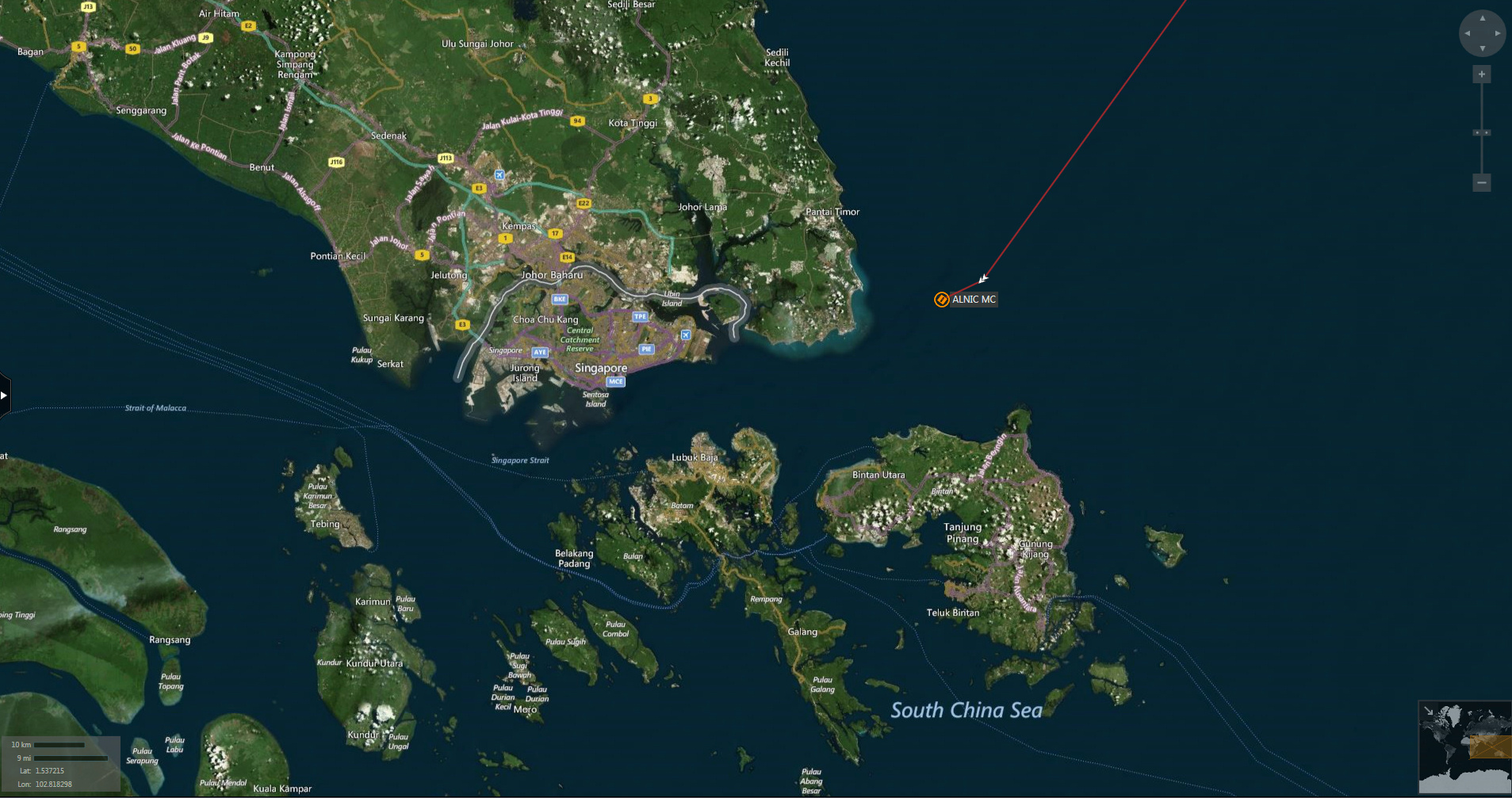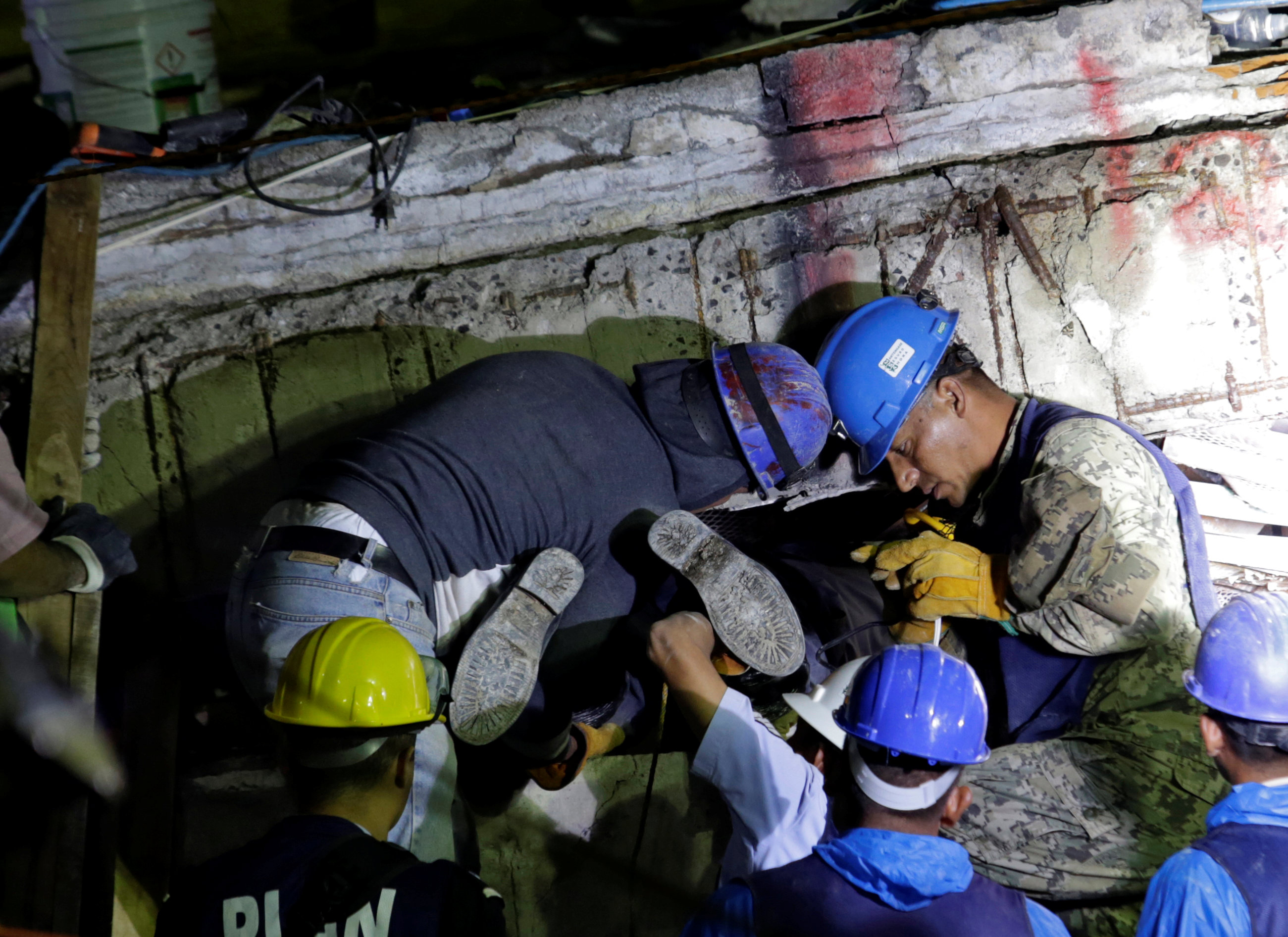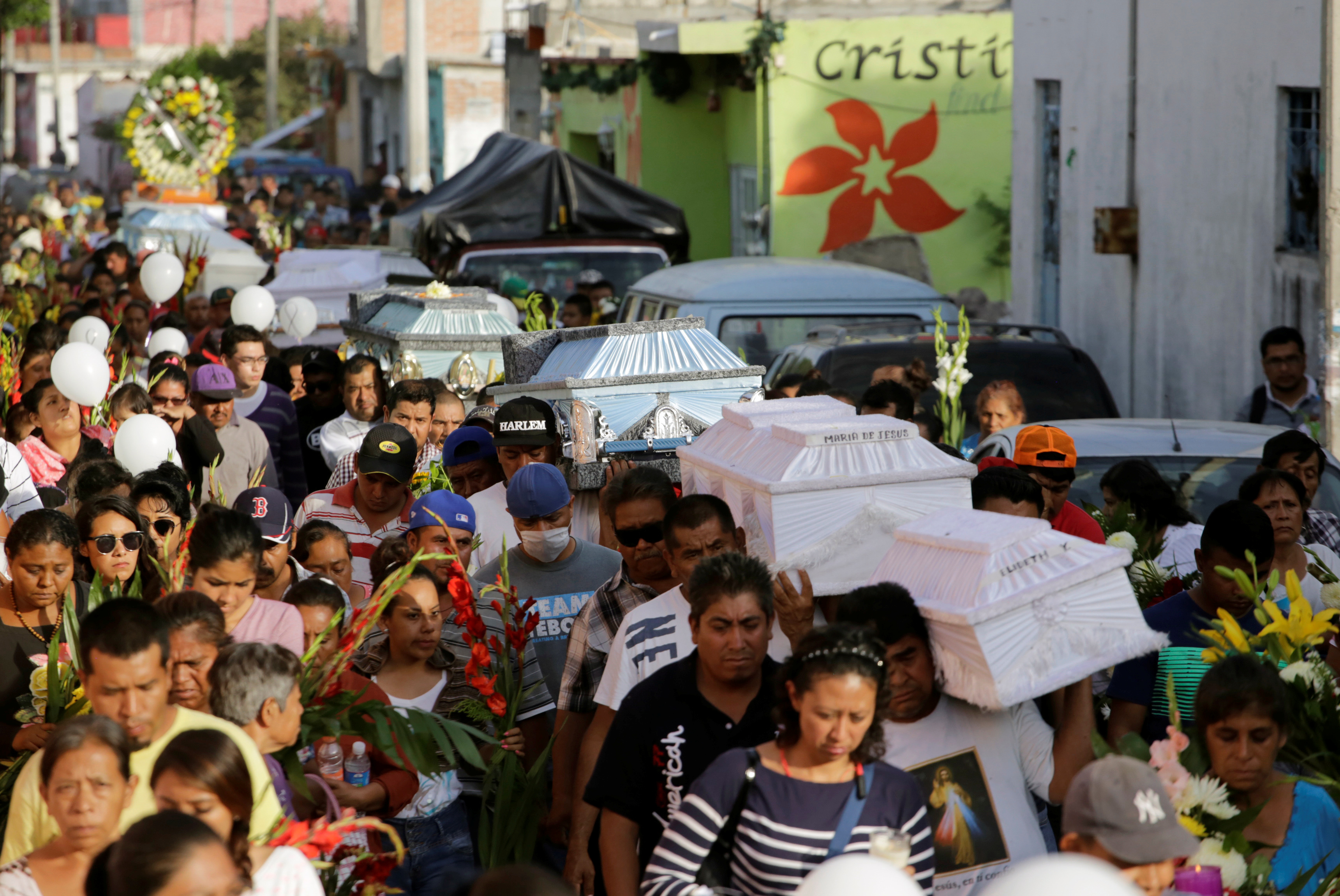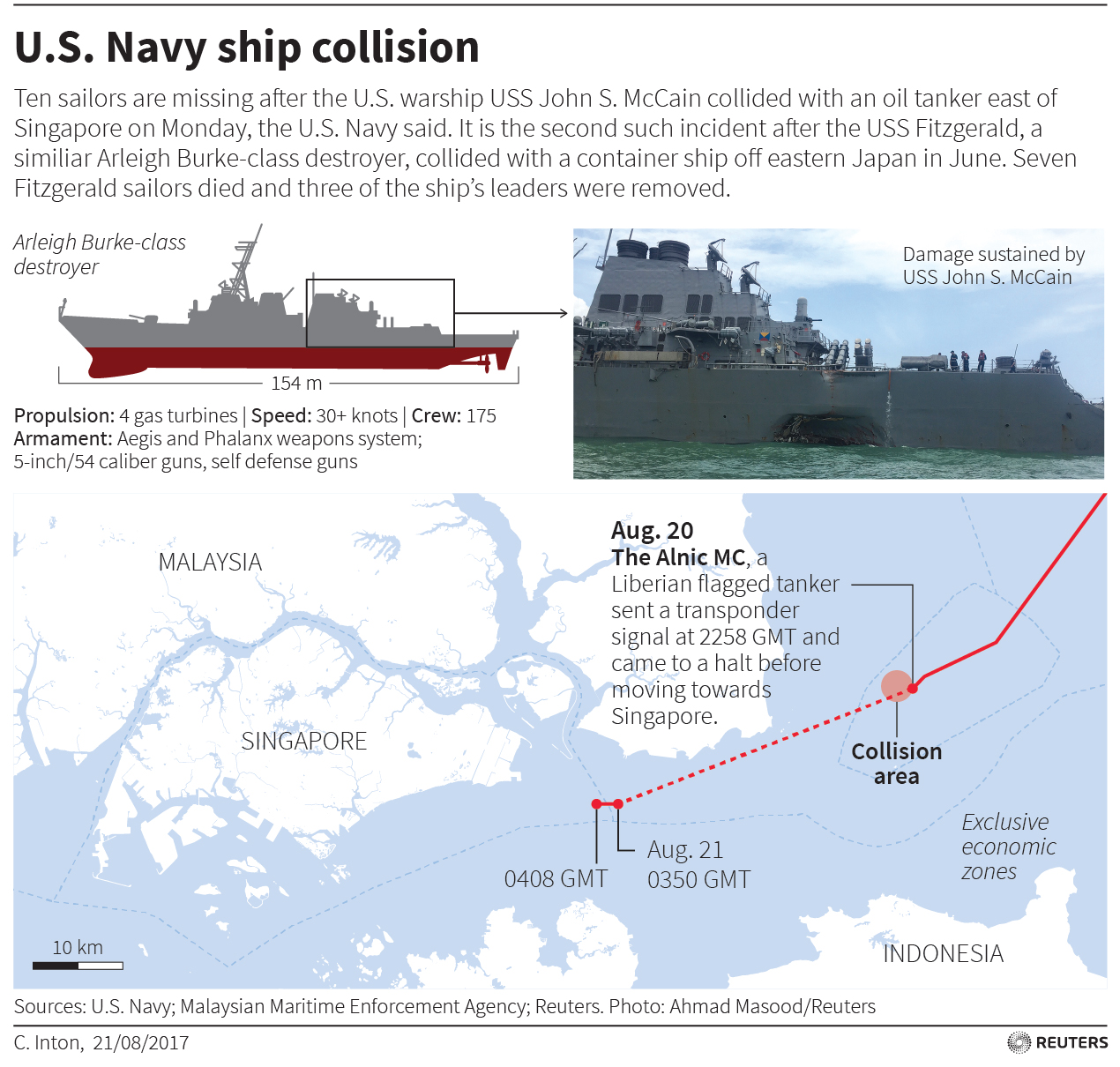
By Fathin Ungku and Masayuki Kitano
SINGAPORE (Reuters) – Ten sailors are missing after a U.S. warship collided with an oil tanker east of Singapore before dawn on Monday, tearing a hole beneath the waterline and flooding compartments that include a crew sleeping area, the U.S. Navy said.
The collision between the guided-missile destroyer USS John S. McCain and the tanker Alnic MC was the second involving a U.S. Navy destroyer and a merchant vessels in Asian waters in little more than two months.
The ships collided while the U.S. warship was heading to Singapore for a routine port call, the Navy said in a statement.
“Initial reports indicate John S. McCain sustained damage to her port side aft,” the Navy said. “There are currently 10 sailors missing and five injured.”
The destroyer had made its way to Singapore’s Changi Naval Base by Monday afternoon under its own power.
Significant damage to the hull had resulted in flooding to compartments, including crew berthing, machinery, and communications rooms, the Navy said, but crew members were able to stop the flooding.

A map shows the location where the Alnic MC merchant vessel came to a halt after a collision with the guided-missile destroyer USS John S. McCain east of Singapore August 21, 2017. REUTERS
Four of the injured were taken by helicopter to hospital in Singapore with non-life threatening injuries. The fifth needed no further treatment.
The USS John S. McCain’s sister ship, the USS Fitzgerald, almost sank off the coast of Japan after it was struck by a Philippine container ship on June 17. The bodies of seven USS Fitzgerald sailors were found in a flooded berthing area.
Collisions between warships and other large vessels are extremely rare, with naval historians going back more than 50 years to find a similar incident.
A search-and-rescue mission was under way for the sailors missing from the USS John S. McCain involving Singaporean ships, helicopters and tugs, as well as U.S. Navy aircraft.
Reuters video footage from the Singapore Strait showed an area of impact about 6 meters (20 ft) wide in the John S. McCain’s port side.
The U.S. Navy later said amphibious assault ship USS America had arrived to provide messing and berthing for crew of the USS John S. McCain. It would also provide support for the search of the missing and divers to assess the damage.
TERRITORIAL DISPUTE
A crew member on the Alnic MC told Reuters by telephone there was no oil spill from the Liberian-flagged, 183 meter-long (600 ft) tanker, which was carrying almost 12,000 tonnes of fuel oil from Taiwan to discharge in Singapore.
“We have not discharged the tanker yet,” said the crew member, who asked not to be identified.
“We are proceeding to Raffles Reserved Anchorage, where the owners will investigate the matter. There was some damage to the valve but no oil spill.”
Stealth Maritime Corporation, the Greece-based owner of the tanker, said the vessel was moving to safe anchorage for assessment. Reuters later saw the Alnic MC anchored off Singapore.
Singapore’s Maritime and Port Authority (MPA) said no injuries were reported on the Alnic, which suffered some damage above the waterline.
“There is no report of oil pollution and traffic in the Singapore Strait is unaffected,” the MPA said, adding that the collision happened in Singaporean territorial waters.
However, the Malaysian navy said the collision happened in Malaysian waters and it had sent vessels to assist.
The Pedra Branca area near where the collision happened has long been contested by both countries, with an international court ruling in Singapore’s favor in 2008. Malaysia filed an application to review that ruling this year.
“The Malaysian agencies are not involved in the search and rescue operations that is led by Singapore,” the MPA said.
The U.S. Navy said Malaysian navy vessels and a helicopter joined the search in the afternoon. Indonesia said it had sent two aircraft and two warships to help.
The waterways around Singapore are some of the busiest and most important in the world, carrying about a third of global shipping trade.
Ben Stewart, commercial manager of Maritime Asset Security and Training in Singapore, said early indications suggested the warship may have turned across the front of the tanker.
“Instances like this should be rare and they are rare,” Stewart said.
The U.S. Navy said last week it had removed the two senior officers and the senior enlisted sailor on the USS Fitzgerald following an investigation into that collision.
SISTER SHIPS
The USS Fitzgerald and USS John S. McCain, built in the same shipyard, are both ballistic missile defense (BMD) capable ships and part of the same Japan-based destroyer squadron. The Seventh Fleet has six ships assigned to BMD patrols, with half on patrol at any time.
The accidents come at a tense time.
The USS John S. McCain carried out a freedom of navigation operation in the South China Sea this month, coming within 12 nautical miles of an artificial island built by China.
The operation was the latest to counter what the United States sees as China’s efforts to control the waters. China denounced it.
North Korea threatened last week to fire ballistic missiles towards the U.S. Pacific territory of Guam after U.S. President Donald Trump said he would unleash “fire and fury” if North Korea threatened the United States.
“Thoughts &; prayers are w/ our US Navy sailors aboard the #USSJohnSMcCain where search & rescue efforts are underway,” Trump said on Twitter.
The U.S. vessel involved in the latest collision is named for the father and grandfather of U.S. Republican Senator John McCain, who were both admirals.
Senator McCain, a Vietnam War naval pilot who was shot down and held prisoner for five-and-a-half years, is undergoing treatment for brain cancer.
“Cindy and I are keeping America’s sailors aboard the USS John S McCain in our prayers tonight – appreciate the work of search and rescue crews,” he said on Twitter, referring to his wife.
(Reporting by Fathin Ungku and Masayuki Kitano; Additional reporting by Henning Gloystein and Jessica Jaganathan, Aradhana Aravindan, Karishma Singh and Sam Holmes in SINGAPORE, Tim Kelly in TOKYO, Joseph Sipalan and Rozanna Latiff in KUALA LUMPUR, Kanupriya Kapoor in JAKARTA, and Lesley Wroughton in WASHINGTON; Writing by Lincoln Feast; Editing by Paul Tait, Robert Birsel)













